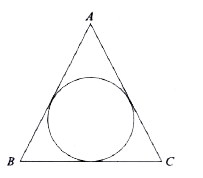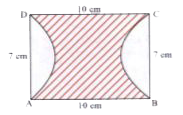Let ABC be an equilateral triangle with side length a. Let R and r denote the radii of the circumcircle and the incircle of triangle ABC respectively. Then, as a function of a, the ratio Rr
strictly increases
strictly decreases
remains constant
strictly increases for a<1 and strictly decreases for a>1
To solve the problem, we need to find the ratio Rr where R is the radius of the circumcircle and r is the radius of the incircle of an equilateral triangle with side length a.
Step 1: Find the circumradius R
For an equilateral triangle, the formula for the circumradius R is given by:
R=abc4×Area
Since a=b=c for an equilateral triangle, we can simplify this. The area A of an equilateral triangle can be calculated using the formula:
A=√34a2
Substituting this into the formula for R:
R=a⋅a⋅a4×√34a2=a3√3a2=a√3
Step 2: Find the inradius r
The formula for the inradius r of an equilateral triangle is given by:
r=Areas
where s is the semi-perimeter. The semi-perimeter s for an equilateral triangle is:
s=a+a+a2=3a2
Now substituting the area into the formula for r:
r=√34a23a2=√34a2⋅23a=√3a6
Step 3: Calculate the ratio Rr
Now we can find the ratio Rr:
Rr=a√3√3a6=a√3⋅6√3a=63=2
Conclusion
Thus, the ratio Rr is:
Rr=2
For an equilateral triangle, the formula for the circumradius R is given by:
The formula for the inradius r of an equilateral triangle is given by:
Now we can find the ratio Rr:
Thus, the ratio Rr is:
Similar Questions
Knowledge Check
In a triangle ABC,r=
A(s−a)tanB2B(s−b)tanB2C(s−b)tanC2D(s−a)tanC2The ratio of the areas of the circumcircle and the incircle of an equilateral triangle is
A2:1B4:1C8:1D3:2ABC is an equilateral triangle of side x cm. The radius of its incircle is
 Ax√3cmB√3xcmC2x√3cmDx2√3cm
Ax√3cmB√3xcmC2x√3cmDx2√3cm
Let the centroid of an equilateral triangle ABC be at the origin. Let one of the sides of equilateral triangle be along the straight line x+y=3. If R and r be the radius of circumcircle and incircle respectively of △ABC, then (R+r) is equal to :
View SolutionLet AD be an altitude in a right triangle ABC with ∠A=90∘ and D on BC. Suppose that the radii of the incircles of the triangles ABD and ACD are 33 and 56 respectively. Let r be the radius of the incircle of triangle ABC. Find the value of 3(r+7).
View SolutionIf R is the radius of the circumcircle of the ΔABCandΔ is its area then
View Solution
In the above figure, ABC is an equilateral triangle of side length √3cm. Radius of incircle is
View SolutionLet ABC be a triangle and O be its orthocentre .If R and R1 are the circum-radii of triangle ABC and AOB , then
View Solution
